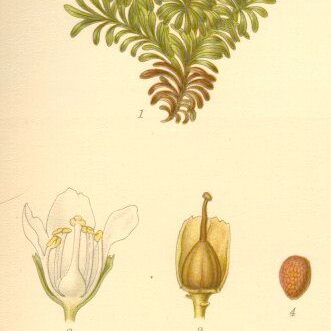Shrublets, prostrate, compact, often forming a mat or cushion. Stems slender, many-branched. Leaves subsessile, often crowded, margin entire. Flowers solitary, subsessile or on a short scape. Calyx with 2 or 3 bracts at base. Corolla campanulate, 5-lobed to middle or more basally, caducous. Staminodes minute or absent. Ovary globose, 3-locular. Style erect, filiform; stigma entire, capitate, or slightly 3-lobed. Capsule 3-locular, ellipsoid or globular, surrounded by persistent calyx; scape elongating in fruit.
Cal deeply 5-parted; cor campanulate, the 5 lobes broadly obovate, about equaling the tube; stamens 5, adnate to the cor to the sinuses; filaments broad and flat; pollen-sacs 2, transversely divergent, opening by longitudinal slits; style slender, elongate; stigma truncate; fr subglobose; dwarf, branched and matted, evergreen subshrubs with mostly opposite lvs; fls white, each closely subtended by 3 bracts, solitary on a terminal peduncle. 4, the others Asian.

